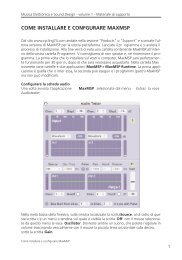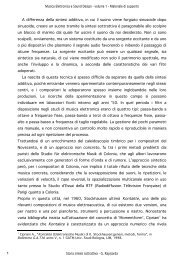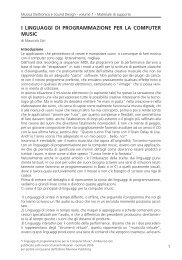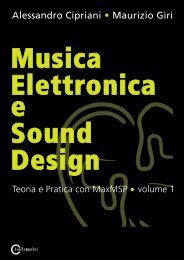programming with max/msp - Virtual Sound
programming with max/msp - Virtual Sound
programming with max/msp - Virtual Sound
Create successful ePaper yourself
Turn your PDF publications into a flip-book with our unique Google optimized e-Paper software.
Chapter 3T - Noise generators, filters, and subtractive synthesis<br />
In digital systems, white noise is generally produced using random number<br />
generators: the resulting waveform contains all of the reproducible frequencies<br />
for the digital system being used. In practice, random number generators use<br />
mathematical procedures that are not precisely random: they generate series<br />
that repeat after some number of events. For this reason, such generators are<br />
called pseudo-random generators.<br />
By modifying some of their parameters, these generators can produce different<br />
kinds of noise. A white noise generator, for example, generates random<br />
samples at the sampling rate. (If the sampling rate is 48,000 Hz, for example,<br />
it will generate 48,000 samples per second.) It is possible, however, to modify<br />
the frequency at which numbers are generated – a generating frequency equal<br />
to 5,000 numbers a second, for example, we would no longer produce white<br />
noise, but rather a noise <strong>with</strong> strongly attenuated high frequencies.<br />
When the frequency at which samples are generated is less than the sampling<br />
rate, “filling in the gaps” between one sample and the next becomes a problem,<br />
since a DSP system (defined in the glossary for Chapter 1T) must always be able<br />
to produce samples at the sampling rate. There are various ways of resolving<br />
this problem, including the following three solutions:<br />
> Simple pseudo-random sample generators<br />
These generate random values at a given frequency, maintaining a constant<br />
value until it is time to generate the next sample. This results in a waveform<br />
resembling a step function. In Figure 3.3 we see the graph of a 100 Hz<br />
noise generator; the random value is repeatedly output for a period equal<br />
to 1/100 of a second, after which a new random value is computed. If the<br />
sampling rate were 48,000 Hz, for example, each random value would be<br />
repeated as a sample 48,000 / 100 = 480 times.<br />
amplitude<br />
�<br />
���<br />
�<br />
����<br />
��<br />
� ���� ��� ���� ���<br />
time<br />
Fig. 3.3 Generation of pseudo-random values<br />
from “Electronic Music and <strong>Sound</strong> Design” Vol. 1 by Alessandro Cipriani and Maurizio Giri<br />
© ConTempoNet 2010 - All rights reserved<br />
3T<br />
297







